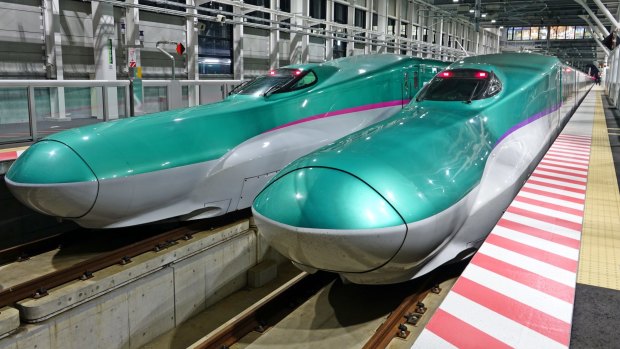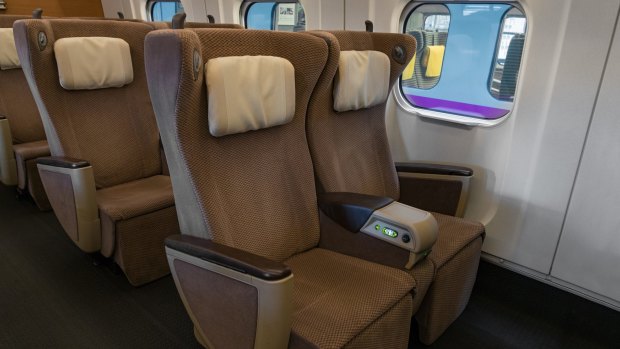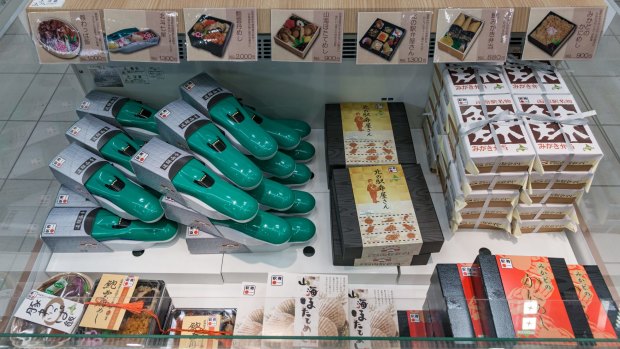This was published 5 years ago
Japan's bullet trains: Hokkaido Shinkansen passes through the world's deepest rail tunnel
By Tatyana Leonov

The Hokkaido Shinkansen trains have a top speed of 320 kilometres per hour.Credit: Shutterstock
We have 20 minutes to change lines. The walk between the platforms is short and we're in Japan – where 20 minutes means precisely 20 minutes. This is our first overseas trip with our infant daughter, so apart from the usual gear we're also lugging around a pram and a travel cot. Then there's the whole travelling with a baby thing… we're still discovering that even when you prepare and plan, babies like to keep things… interesting.
For our first international jaunt we've chosen Japan – because it's considered to be safe, family-friendly and easy to get around. There are elevators everywhere, food is easy to find, and toilets are bizarrely fancy, with nature-inspired soundtracks and high chairs found inside many cubicles to make parents' lives easier.
We've spent one full day in Hakodate and are up early to catch the local train from Hakodate Station to Shin-Hakodate-Hokuto Station, which takes just under 20 minutes. Although local trains and the bullet train arrive into the same station, you need to transfer via gates located on the ground level to get to the Shinkansen platforms. We present our tickets and Japan Rail Passes at the counter, then scurry over to the platform. As we predicated, we don't have quite enough time to stop to get our lunches – but planning ahead we organised bento boxes the day before. It's been a long time since we first jumped on one of Japan's Shinkansens and we're not sure what to expect.

The Green Car (business class equivalent) is fitted out in a 2-2 configuration. Credit: Shutterstock
Japan unveiled its first Shinkansen to the world at the Tokyo Olympics in 1964, and in the years since it has gained a reputation as one of the leading countries (if not the lead country) in the world for its efficient and speedy train network. The island of Hokkaido, however, could only be accessed by local trains until only recently.
Japan's newest Shinkansen – the Hokkaido Shinkansen – was launched in March 2016. The new line connects Aomori (on Japan's mainland, Honshu) to Hakodate (on the island of Hokkaido) via the Seikan Tunnel – which is the deepest railway tunnel in the world at 240 metres below the sea surface. Until recently, it was the longest railway tunnel at 53.85 kilometres – that is until 2016 when the Gotthard Base Tunnel in Switzerland opened extending for 57.09 kilometres.
From Aomori, the Tohoku Shinkansen then continues on to Tokyo, making the Tokyo to Hakodate journey possible in four hours; the same journey took around five-and-a-half-hours previously. And that's just for now. The plan is for the route to extend to Sapporo, Hokkaido's capital, by 2030.

Called ekiben (eki meaning station and ben is short for bento, meaning Japanese lunch box), there are many ekiben choices at large train stations in Japan, often with produce from the regional area showcased in the take-away packs.Credit: Shutterstock
The new route was welcomed with open arms by Hokkaido locals, optimistic that it would bring more people in – particularly into Hakodate, a bustling and beautiful city located at the southern tip of Japan's northern-most island. It did. In the first year of operation, 2,292,000 people jumped on board the new Shinkansen, which is 1.64 times the number of passengers who travelled the same route on the slower trains the year prior.
For holiday-makers travelling to Hokkaido, Sapporo is usually the first port of call. In winter, this is where the ski bunnies fly into, scattering out to Niseko, Furano, Tomamu, Rusutsu and other ski fields for adrenalin-fuelled adventures in Japan's famous powder-white snow. Summer explorations on the island encompass nature escapes and onsen relaxations. And that's exactly what we did before making our way to Tokyo. We flew into Sapporo (via Tokyo), where we spent a few days checking out the sights before hiring a car and venturing further north for flower field walks, onsen baths and too much soft-serve ice cream. Then, back to Sapporo to return our car and jump on the local train to Hakodate.
If you plan to catch the train from Tokyo to Sapporo (or vice versa), it's worth considering breaking up the journey across two days and spending a day in Hakodate. The seaside city has seen a recent tourism boom, thanks largely to the new Shinkansen route. Some of the must-dos include taking in wonderful views from the top Mount Hakodate, strolling through Hakodate Morning Market, exploring the massive Fort Goryokaku, and hanging out with Hakodate hipsters in the Kanemori district, where historic red brick warehouses have been transformed into boutique shops and dessert cafes.
After a full day of exploring Hakodate, we're ready to glide to Tokyo.
Our bullet train's exterior is a deep green with a thick purple-pink stripe, which represents Hokkaido's famous flower fields. Inside, grey-brown upholstery and wood panelling make for a soothing ambience. We are travelling in a reserved seats carriage and the configuration is 3-2. We've lucked out with a row of three as the seat next to us is empty for most of the journey, so bub gets her own space (children aged five and under travel free, but don't get assigned a seat). Predictably (we're in Japan, after all), there are power points at every seat.
Shinkansen trains in Japan always run on time and there are no bells or whistles indicating that the train is leaving shortly. My husband and I take turns jumping on and off the train as we look around for coffee, but we both make sure we're back on board a few minutes before the scheduled departure.
The train pulls out of the station right on time, and so our journey begins. Soon we're rocketing through the Seikan Tunnel and it feels as if we're out as quickly as we soared in. Interestingly, although the train we are in has a top speed of 320 kilometres per hour (the Hayabusa Shinkansen series is the fastest train in the country), it has to slow down to 140 kilometres per hour in the tunnel so passing freight trains don't lose their loads – a risk caused by wind pressure as trains pass each other. Even so, it feels like we are flying. As the journey progresses we will reach speeds of 260 kilometres per hour.
Everyone on board is well behaved and quiet. The only voices heard are that of the food cart attendant and her clients. The food choices are limited to snacks and drinks, but most people buy their bento lunch boxes at train stations before boarding. Called ekiben (eki meaning station and ben is short for bento, meaning Japanese lunch box), there are many ekiben choices at large train stations in Japan, often with produce from the regional area showcased in the takeaway packs.
I go for a walk to check out the other cabins as we get closer to Tokyo, curious to see how the rest of the train is laid out. The Green Car (business class equivalent) is fitted out in a 2-2 configuration. Gran Class is the super luxurious option (first class), with spacious seats set out in a 2-1 configuration, and only available on selected Shinkansens. At the entry to the carriage there's a sign requesting only Gran Class passengers are permitted to enter the cabin, but I naughtily press the entry button and a sliding door opens to reveal how the other half live. I get a few inquisitive looks and quickly scamper back to my seat.
By the time we glide into Tokyo every seat is occupied and there are plenty of people standing; we're coupled with a business man trying to have a nap. Of course, this is the only time during our four-hour journey that our bub decides she wants to babble away at the top of her voice.
TRIP NOTES
PURCHASE THE RIGHT TICKET
You can purchase a one-way train ticket from Tokyo Station to Shin-Hakodate-Hokuto Station or vice versa, but the Japan Rail Pass is a more economical option for travellers who plan to catch other trains while in Japan. The journey is covered by the Japan Rail Pass.
RESERVE YOUR SEAT IN ADVANCE
Seat reservations doesn't cost any extra with a Japan Rail Pass, so if travelling a fair distance it's worth booking seats in a reserved seat carriage. You can do this at any JR ticket office by presenting your pass (after you have already activated it).
ARRIVE TO THE STATION EARLY
Trains in Japan are always on time, so arrive well before the scheduled departure to avoid rushing. At larger stations, it's common for passengers to queue up at the carriages up to 30 minutes before the train is scheduled to leave.
ALWAYS HAVE YOUR JAPAN RAIL PASS ON YOU
Even with reserved seat vouchers, you will need to show your Japan Rail Pass when entering the train station, and also while travelling on the trains. Keep it together with your voucher somewhere that is easily accessible.
STOCK UP FOR THE JOURNEY
You can buy drinks and snacks on board, but arriving to the station early gives you time to buy ekibens, snacks and drinks to make for a comfortable trip.
Tatyana Leonov travelled on the Shinkansen as a guest of JNTO.
See also: 20 things that will shock first-time visitors to Japan
Sign up for the Traveller Deals newsletter
Get exclusive travel deals delivered straight to your inbox. Sign up now.